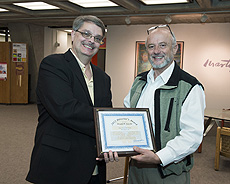Don Lincoln receives Director's Award for volunteer service
 |
Fermilab scientist Don Lincoln is the recipient of this year's Director's Award for his contributions to science education. Photo: Reidar Hahn
|
Don Lincoln is a familiar name around Fermilab. His byline frequently appears after Fermilab Today articles. He's given numerous public talks at the laboratory. And every time he's asked to address a student group, whether they're undergraduates visiting the laboratory or kindergartners in their classrooms, he happily obliges.
On Oct. 25 Fermilab Director Pier Oddone presented Lincoln with the Director's Award, given annually to an employee, user, graduate student, retiree or guest scientist who contributed significantly to Fermilab's K-12 education programs.
"He's a terrific volunteer," said Marge Bardeen, head of the Education Office. "It's obviously something he's deeply interested in, and he works from a sense of responsibility to communicate with different audiences about the science we do."
That sense of responsibility stems from a sense of appreciation. Lincoln grew up in a blue-collar world in which a college education was a foreign concept. Although he had supportive parents, at an early age he began to have questions they could no longer answer. To satisfy his curiosity, he turned to science popularizers such as George Gamow and Carl Sagan. Their writings not only drew him into the worlds of particle physics and cosmology, they inspired him to create his own place in the world of popular science.
"I do this because somewhere out there, there's a kid in exactly the same situation I was in," he said. "Just this summer, a student came to me and said, I'm in particle physics because of your book."
Over the years, his reach has grown. He's written three books, several magazine articles and blog posts for PBS's NOVA. His videos on Fermilab's YouTube channel are among the laboratory's most popular.
"I use these videos when giving talks to the public and in Washington," Fermilab Director Pier Oddone said. "Volunteers for science education have an effect well beyond the classroom."
Four other nominees received certificates for this year's Director's Award: Todd Johnson, AD; Terry Kiper, PPD; Jim Zagel, AD; and Jerry Zimmerman, PPD.
"While I am very excited by Fermilab's research program and lucky to be a part of it, I think it is incredibly important to share with the public what we've discovered." Lincoln said. "Why should we scientists have all the fun?"
The annual award is made possible by an anonymous donor to Fermilab Friends for Science Education, a not-for-profit organization supporting science education programs at Fermilab.
—Leah Hesla
|